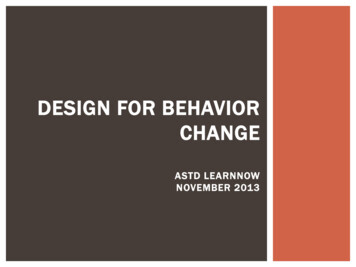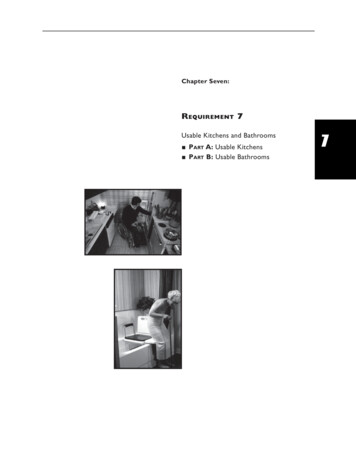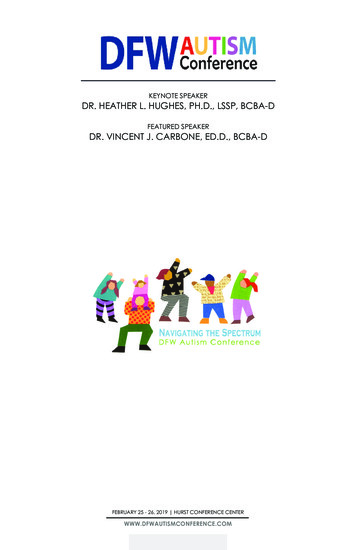
Transcription
DESIGN FOR BEHAVIORCHANGEASTD LEARNNOWNOVEMBER 2013
WHAT IS THE FUTURE OF LEARNING? What does Learning &Development have in commonwith Museums and Libraries?
ACTIVIT Y What does thefuture of Learning &Development looklike in: 10 years 20 years 50 years?
SO WHAT IS THE FUTURE? What does thefuture look like?We’ll just get this one out of the way
MOTIVATION WE CARE ABOUT Motivation to Learn Motivation to Do
THE HARD PROBLEMS Part of the future: Learning to deal with the hard problems
I KNOW, BUT “I know it’s a bad idea, and Inever do it (except when I do, andthen I feel guilty).” “I know it’s a bad idea, but I onlydo it once in a while, and I’m verycareful.” “I know it’s a bad idea for otherpeople, but I can do it because I’mreally good at it.” “Huh? What’s the big deal?”
ACTIVIT Y Create an “I know,but ” Persona Name/description Behavior (or lack ofbehavior) Individual rationale Organizationalrationale
EXAMPLECraigData EntryClerkCraig is anexperienced dataentry clerk. He’sfast, and regularlygets the bonusfor exceeding therequiredapplications perhour, but hisaccuracy is poor,and he doesn’tstop to check formissing data atthe point ofentry.Data entry clerksare frequentlycareless, and theydon’t know theimpact of enteringwrong orinaccurate data.“I’m faster thananybody, and somemistakes areunavoidable. Thedata still goesthrough.”
IF IT’S NOT AKNOWLEDGE PROBLEM,MORE INFORMATIONWON’T HELP.So what willhelp?
SO, WHAT WILL HELP?What is design forbehavior change?Creating an environmentthat makes it easier tomake good choices.
HOW DO WE MAKE CHOICES?Decisions are: Emotional Social Automatic Expedient
EMOTIONAL DESIGN
LET’S START WITH THE ELEPHANT Let’s talk about attention Jonathan Haidt, The Happiness Hypothesis
THE RIDER
THE ELEPHANT
SO, WHEN THERE’S A CONFLICT Who do you think wins?
URGENCY MATTERSWe are creatures of urgency:Basically, the elephant isbad at waiting for stuf f.Maybe I shouldconsiderretirementplanning
WE HAVE TROUBLE WITH THIS We are also loss averse
IT’S ABOUT CAKE VS FRUIT SALADShiv and Fedorikhin 1999Heart and Mind in Conflict: The Interplay of Affect and Cognition in Consumer Decision Making
PURPOSE Instead of WIIFM, How aboutWCIDW T?
WCIDWT?
GOALS ACCOMPLISHMENTS A goal needs to be an accomplishmentI crushed the quarterlysales goal!You completed Module 4!
WHAT DO WE REALLY MEAN WHEN WE SAY“WE LEARN FROM EXPERIENCE?”Let me tell you a story about a friend ofmine
HERE’S THE THING. the elephant isn’t stupid.This sucks I amnot doing thisagain
WE LEARN FROM EXPERIENCEHow many of you know that it’s badto text while driving?How many of you learned thisthrough personal experience?
SO, LET’S BREAK THIS DOWN What areeach of thesedriverslearning fromtheirexperiences?
WHEN WE THINK ABOUT LEARNINGEXPERIENCES Experience inthe worldExperiencein thetraining
BUT, VISCERAL MATTERS TOO report.pdf
VISCERAL MATTERSHow about some the fruit salad or 3p278-92.html
DESIGN FOR THE ELEPHANThttps://www.youtube.com/watch?v R0LCmStIw9E
RATIONAL DECISION MAKING
SUSPENSION /documentos/dutton&aron1974.pdfPhoto by Mike Taylor
ACTIVIT Y What experience do peoplehave when they tr y ? (reward,punishment, reinforcement, noresponse) What is the consequence ifthey don’t take the desiredaction? Is there anxiety, fear ordiscomfor t associated with thechange? How does the per son know ifthey are doing it right? Howdoes the organization know?
SOCIAL DESIGN
WE USE OTHER PEOPLE AS CUES FORHOW TO ACT
WE LISTEN TO AUTHORIT Y FIGURES
OPINION LEADERS, TESTIMONIALS,SUCCESS STORIES
PRACTICE CAN BE MORE IMPORTANT THANKNOWLEDGE
ACTIVIT Y Who are the opinion leaders? Are the opinion leader s par t ofthe change? Are people able to see other susing the new behavior? Are they able to tr y out thenew behavior in a safeenvironment? How confident do they feelabout their ability to make thechange?
DESIGN FOREXPEDIENCE ANDAUTOMATICITY
FIRST, LET’S START WITH ATTENTION How long is your attention span?
WHICH DO YOU THINK WORKS BETTER:I guess I’llbe glad Iknow thissomeday I’m reallyglad I knowthis now
AND THE FUTURE IS SOOOOO FAR AWAY
Glucose Metabolic Rate after several weeks of Tetris Practice
THERE’S SYSTEM 1 AND 2Things we do automatically System 1: Fast,automatic, frequent,emotional, stereotypic,subconsciousDaniel Kahneman – Thinking Fas t and SlowThings we think about System 2: Slow,effortful, infrequent,logical, calculating,conscious
AUTOMATICIT Y CAN BE ACQUIRED
WE DEVELOP UNCONSCIOUS COMPETENCE FamiliarizationComprehensionConscious Ef fortConscious ActionProficiencyUnconscious CompetenceGloria Gery, Electronic Performance Support Systems
THE ELEPHANT IS A CREATURE OF HABIT
WE DEVELOP UNCONSCIOUS COMPETENCEGlucose Metabolic Rate after several weeks of Tetris PracticeHaier et al, 1992
CHANGE IS HARDIf you are used to this:Then this feels bad:
THIS AFFECTS MOTIVATION AND SELFRemember the fruit saladCONTROLor 3p278-92.html
ACTIVIT Y Do people have to unlearn previousbehaviors? How are they getting practice in thenew behavior? Are they able to use the new behaviornow? How soon do they see benefits from thebehavior? How well does the environment suppor tthe behavior? Can any of the cognitive load beof fshored to the environment (systems,job aids, mobile suppor t)?
DESIGN FOR THEENVIRONMENT
ANSWER 10: ENVIRONMENT MATTERS
DESIGN CHANGES BEHAVIOR
MAKE IT EASY FOR PEOPLE TO SUCCEED
CREATE AN ENVIRONMENT THAT SUPPORTSTHEM
USE GOOD MODELS - TAMTechnology Acceptance ModelPerceivedUsefulnessPerceivedEase of UseTechnologyAcceptance
USE GOOD MODELS – DIFFUSION OFINNOVATION Relative abilityEverett Rogers , Diffusion of Innovations
FIX THE ENVIRONMENT
ACTIVIT Y
EXAMPLE Craig Data Entry Clerk Craig is an experienced data entry clerk. He's fast, and regularly gets the bonus for exceeding the required











